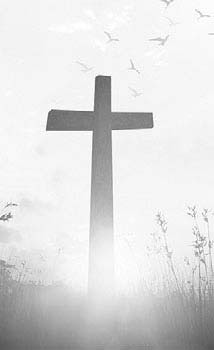Is God Dead?
Last time, we began to look at three broad categories of criticism raised against the Christian resurrection narrative: First, critics claim the Christian resurrection is a legend that began long ago and has been perpetuated and perfected over time. Second, critics claim the Christian resurrection narrative violates Ockham’s razor.
And the third category of criticism against the Christian resurrection narrative is that the supporting sources of evidence are deficient. This week, we begin by taking a closer look at the claim that the resurrection narrative is legend. In order to make certain we are standing on common ground with the Bible skeptic, we need to define and establish what “legend” truly is. It just so happens we have a wonderful example of a resurrection legend. Listen to the resurrection scene from the non-canonical Gospel of Peter.
But in the night in which the Lord’s Day dawned when the soldiers were safeguarding it two by two in every watch, there was a loud voice in heaven, and they saw that the heavens were opened and that two males who had much radiance had come down from there and come near the sepulcher.
But that stone which had been thrust against the door, having rolled by itself, went a distance off the side, and the sepulcher opened, and both the young men entered. And so those soldiers, having seen, awakened the centurion and the elders (for they too were present, safeguarding). And while they were relating what they had seen, again they saw three males who had come out from their sepulcher, with the two supporting the other one, and a cross following them, and the head of the two reaching unto heaven, but that of the one being led out by a hand by them going beyond the heavens.
And they were hearing a voice from the heavens saying, ‘Have you made proclamation to the fallen- asleep?’ And an obeisance was heard from the cross, ‘Yes.’” Can you see it? I mean, it is hard to miss: soldiers, guards, Jewish elders, all just hanging out at the tomb. Two giant angels are carrying Jesus. Jesus is huge as well, and all their heads reach all the way to heaven. Then a talking cross is following them? Needless to say, that is what ancient Near East legend sounds like. Now compare that to the mundane resurrection narrative penned by Mark. For critics to claim that the Gospel accounts, especially Mark’s unpretentious account, are legend, is without basis. Little wonder why the Gospel of Peter was not canonized into the Bible (because it is a legend).
Further, we need to remember that our bedrock facts are based upon a universal consensus of scholars. Remember, this is a group of scholars across all beliefs, from atheist to Christian, liberal to conservative. Consequently, arguing that the resurrection sources are legends seems invalid.
But there is still more.
The second criticism category involves critics claiming that the Christian resurrection hypothesis violates Ockham’s razor.
Ockham’s razor is a problem-solving principle (also termed the principle of parsimony) that was developed in the 14th century by a Franciscan friar named William of Ockham. In a nutshell, Ockham’s razor says that when comparing a group of theories on the same subject, the simplest theory with the fewest assumptions should be selected. In other words, it is a scientific principle that things connected to one another behave most simply and economically. The principles of Ockham’s razor are sometimes applied to aesthetics, as noted in various art forms. “The beauty of simplicity” is an example. We discussed the Golden Ratio and its relationship to aesthetics many weeks ago. That perfect ratio that is aesthetically pleasing to the human eye: that ratio of 1:1.618. This ratio is said to be simple, and the objects that follow that ratio are said to be “simply beautiful.”
This concept is carried over into logic; Ockham’s razor is one of the core tenets of sound philosophical reasoning, and, as noted above, its principle is also used in scientific reasoning. It has been applied to the scientific method of evaluating competing hypotheses and used in architecture, philosophy, and religion. Even so, critics of the Christian resurrection state that the story is more complex and requires a greater amount of assumption than competing naturalistic explanations. Keeping with Ockham’s razor, a naturalistic theory of the resurrection, like Michael Goulder’s mass hallucination theory, should be favored, so says the critic.
However, here again, the critics argue that the Christian resurrection theory presupposes God. In other words, the Christian claim cannot function without acknowledging the Causal Agent. I do not think this is true. We need not confirm or deny the existence of God to be able to look at the resurrection as a historical event methodically. In addition, it can just as easily be argued that the naturalistic explanation that relies upon a series of hallucinations, including several communal hallucinations, is actually more complex, and therefore, naturalistic theories violate Ockham’s razor to a higher degree. In addition, most of the Altered State of Consciousness (ASC) based theories rely upon the “psychoanalytical postulation” by non-trained historians, psychoanalyzing people in abstention from an ancient culture who lived over two thousand years ago, based solely on non-evidenced assumptions. Therefore, claiming that the Christian resurrection model violates Ockham’s razor more than naturalistic resurrection theories is invalid.
Join us again next time as we continue to look at classical criticisms of the Christian resurrection narrative. Until then, ask a close friend, is God dead?
Gloria in excelsis Deo!
Ty B. Kerley, DMin., is an ordained minister who teaches Christian apologetics and relief preaches in Southern Oklahoma. Dr. Kerley and his wife, Vicki, are members of the Waurika church of Christ and live in Ardmore, OK. You can contact him at dr.kerley@ isGoddead.com.

.jpg)


